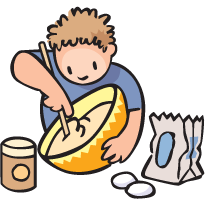Boston Children's Museum
308 Congress Street, Boston, MA 02210
617-426-6500
© Boston Children’s Museum 2025
Website Design by JackrabbitCooking activities, even simple ones like this, are filled with great learning opportunities. Along with measurement and math skills, kids can develop problem solving and literacy skills as well. By experimenting with the ways that certain ingredients act and react with each other, children will gain an understanding of basic cooking chemistry, and will even learn about design as they create and make changes to their cupcake “prototypes”.
This activity is a follow up to Cupcake Science. If you have not yet completed that activity, try it first, followed by Cupcake Science – The Fizz Factor, then move on to this activity.
Key ingredients are flour, sugar, baking powder, egg beaters, milk, salt, butter (or oil) and vanilla. You can introduce any other ingredients as you’d like, although keep in mind that the more ingredients you have, the more complex the recipes will be and the more you’ll need to prepare for the activity. Management of the ingredients will be much easier if they are divided into several cups. For a class of 24 children, you should prepare 4 cups of each ingredient. If you divide children into teams of 3 for this activity (making 8 teams), then 2 teams can share a set of ingredients. Make sure to label the cups with the ingredient that is in them—sugar and salt can look very similar!

Have your students refer to their recipes from the first cupcake baking session. Is there anything they would change? What did they like about their recipes? Tell them that they will now have a chance to improve upon their first attempts. Make sure that they are referring to their first recipe as they create a new recipe. What did they learn from last time that will help them with this new cupcake?
Can you make improvements to your cupcake recipes?
Repeat the process from the Cupcake Science activity, and see if they have reinforced or updated their assessments about the different ingredients in the cupcake batter. Encourage them to make changes to their recipes based on what they observed the first time. If their cake was too fluffy, what will they change? If it was too dense, what might they change then? If it didn’t taste the way they wanted it to, what will they change to improve that?
While the cupcakes are baking, bring your students together to talk about the process. What did they change from their first recipe? What did they observe that led them to that change? How do they think their cakes will turn out this time?
If time allows, offer them some new ingredients, like cinnamon, cocoa, chocolate chips—even frosting! Ask them what differences these ingredients might make in how their cupcakes turn out. Give them a chance to test their theories by baking more cupcakes.